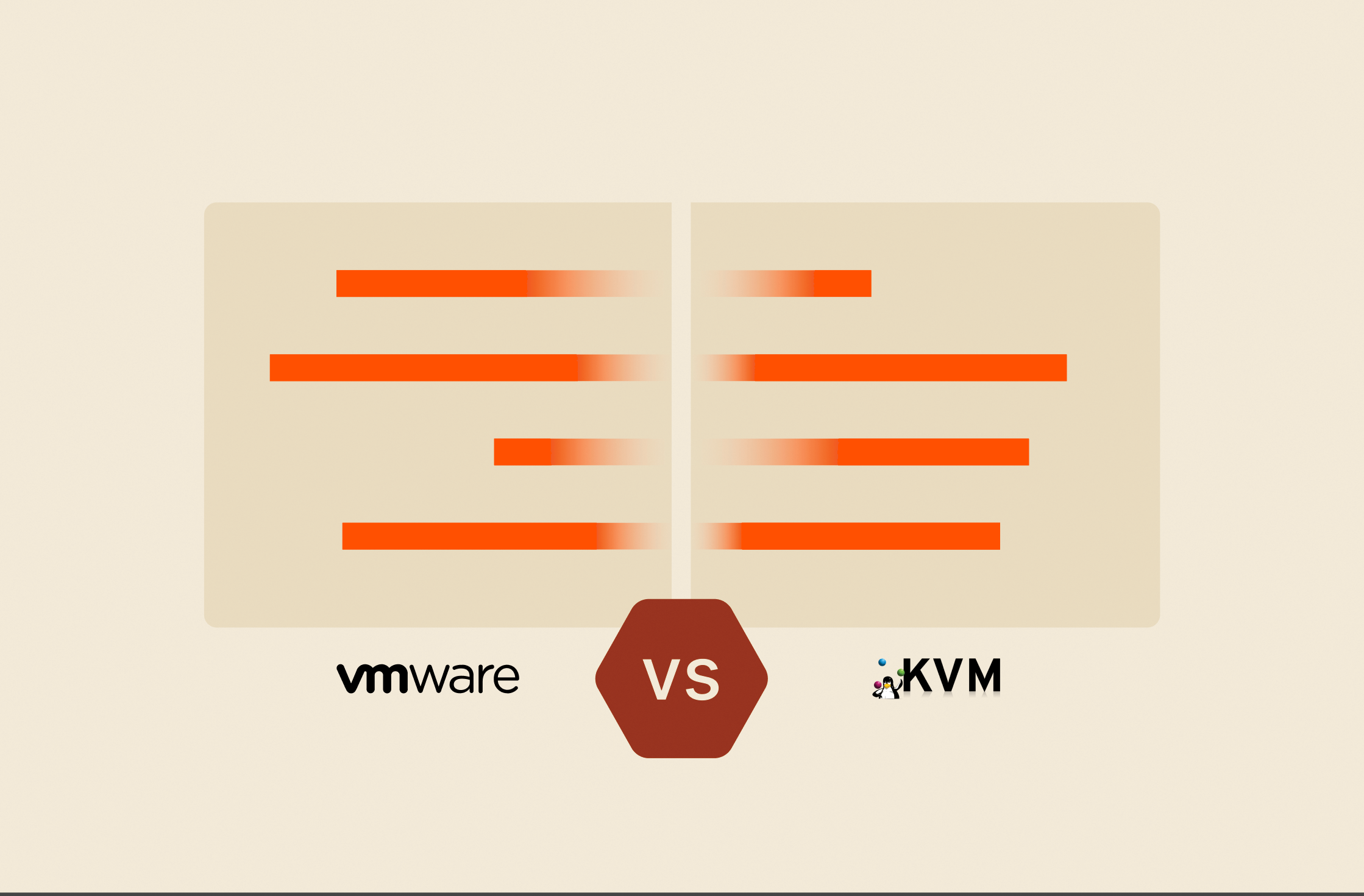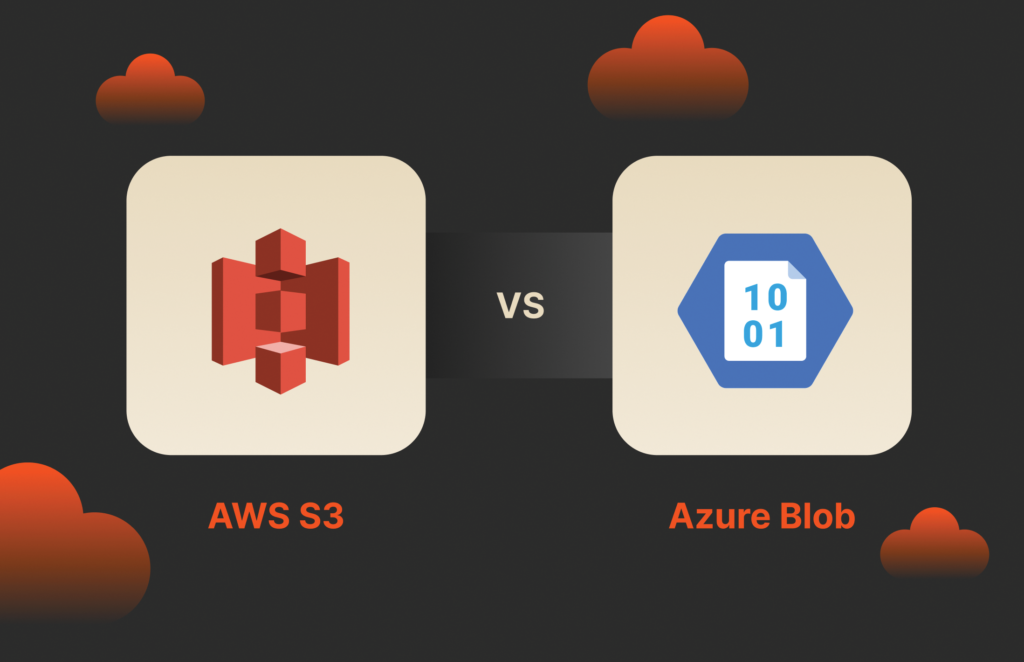Summary
VMware offers a comprehensive suite of features and robust management tools for virtualization. KVM is an open source virtualization technology that is integrated directly into the Linux kernel.
Virtualization and containerization are some of the most common buzzwords in the modern IT space. VMware and KVM are two of the biggest names in the game. But what exactly sets them apart, and how do you choose between them?
Virtualization allows you to run multiple virtual machines on a single physical server, making your IT infrastructure more efficient and flexible. VMware has been a major player in this space for years, and it’s known for its comprehensive suite of features and robust management tools. On the other hand, KVM, which is built into the Linux kernel, offers a cost-effective and open source alternative.
To better leverage the unique offerings of these tools, it’s important to understand their core differences. This guide will break down what each platform offers, helping you decide which one best fits your organization’s needs.
What Is VMware?
VMware is a pioneer and leader in the virtualization industry, offering a comprehensive suite of products that provide advanced features and powerful tools for managing virtual machines. At the core of VMware’s offerings is vSphere, built around the ESXi hypervisor—a Type 1 hypervisor that operates directly on physical hardware.
VMware’s primary appeal lies in its enterprise-level features and robust support ecosystem. It provides a highly scalable, secure, and manageable environment, making it a top choice for large enterprises and organizations with complex IT infrastructures. Whether you’re running data centers, handling cloud workloads, or managing multi-tenant environments, VMware’s suite of tools offers a level of reliability and functionality that stands out in the industry.
Key Features of VMware:
- vMotion: Enables live migration of VMs with no downtime, ensuring business continuity
- Distributed Resource Scheduler (DRS): Automatically balances resources across clusters for optimal performance
- High availability (HA): Automatically restarts VMs in case of host failure, minimizing downtime
- vSAN: Software-defined storage for pooling storage resources across multiple hosts, simplifying storage management
- Comprehensive management tools: Centralized management via vCenter Server for streamlined operations
- NSX: Network virtualization and security platform for software-defined networking
VMware’s long history, continuous development, and extensive ecosystem make it the go-to solution for companies that prioritize reliability, advanced features, and enterprise-level support.
What Is KVM?
Kernel-based Virtual Machine (KVM) is an open source virtualization technology integrated directly into the Linux kernel. This unique architecture transforms the Linux kernel into a Type-1 hypervisor, making KVM a lightweight and highly efficient virtualization solution.
KVM is often favored in open source environments and by businesses looking for a cost-effective virtualization platform that provides flexibility and strong performance. Unlike VMware’s all-in-one approach, KVM is typically combined with other open source tools like Libvirt, QEMU, and OpenStack for managing virtual machines and cloud environments, offering a more modular approach to virtualization.
Key Features of KVM:
- Native Linux integration: Operates as part of the Linux kernel for seamless performance and efficiency
- Open-source flexibility: Allows for extensive customization and modification to suit specific needs
- Security: Built-in features like SELinux and sVirt for enhanced isolation and security
- Cost-effective: No licensing fees make it an attractive option for organizations on a budget or those scaling rapidly
- Hardware-assisted virtualization: Utilizes CPU virtualization extensions for near-native performance
- Wide compatibility: Supports various guest operating systems, including Windows and Linux distributions
KVM is an ideal solution for organizations already heavily invested in Linux environments or those seeking an open source, cost-efficient alternative to proprietary solutions like VMware.
VMware vs. KVM: Performance Comparison
Both VMware and KVM deliver excellent performance, but their strengths shine in different areas.
VMware excels in large-scale, enterprise environments where resource management is critical. Features like DRS and vMotion ensure that workloads are efficiently distributed and VMs can be migrated without downtime. VMware’s optimization for enterprise workloads gives it an edge in resource-heavy operations and complex environments.
- Resource management: VMware’s DRS provides advanced algorithms for balancing workloads across hosts, ensuring optimal performance.
- Memory optimization: Technologies like Transparent Page Sharing and memory ballooning help maximize memory utilization.
- Storage performance: Integration with vSAN and support for NVMe over Fabrics enables high-performance storage solutions.
KVM, on the other hand, integrates directly with the Linux kernel, making it incredibly efficient in Linux environments. This close integration reduces overhead, resulting in near-native performance for many workloads.
- Low overhead: Direct kernel integration minimizes the virtualization layer, reducing performance impact.
- I/O performance: KVM’s paravirtualized drivers (virtio) offer excellent I/O performance for supported guest operating systems.
- Scalability: KVM can handle a large number of virtual machines on a single host with minimal performance degradation.
While KVM may not have the advanced resource management tools that VMware offers out of the box, its lightweight architecture makes it suitable for environments that prioritize raw performance with minimal management overhead.
VMware vs. KVM: Scalability
VMware is designed with enterprise-level scalability in mind. Whether you’re running a small cluster or a massive data center, VMware’s ability to scale across multiple hosts, integrate with software-defined networking (SDN), and handle thousands of VMs makes it a natural fit for large, complex environments.
- vCenter Server: Allows management of thousands of VMs across multiple vSphere clusters
- Cross-cloud architecture: Enables seamless scaling across on-premises and public cloud environments
- vSAN: Scales storage resources linearly by adding new nodes to the cluster
KVM is also highly scalable but requires more manual configuration or additional tools to match VMware’s out-of-the-box capabilities. KVM scales well in cloud environments, especially when combined with management platforms like OpenStack.
- OpenStack integration: Provides a framework for managing large-scale KVM deployments
- Modularity: Allows for custom scaling solutions tailored to specific needs
- Cloud provider adoption: Many major cloud providers, including Google and IBM, use KVM to manage large-scale environments, proving its capability in high-demand situations.
While KVM offers excellent scalability, it lacks some of the advanced automation and resource management features found in VMware, which could result in a steeper learning curve when scaling large environments.
VMware vs. KVM: Ease of Use
Ease of use is one area where VMware clearly outshines KVM. VMware’s vCenter offers a centralized and intuitive interface for managing virtual machines, making it easier for IT administrators to configure, deploy, and monitor environments.
- User-friendly interface: vSphere Client provides a comprehensive GUI for managing all aspects of the virtualized environment.
- Automation: PowerCLI and vRealize Automation enable complex task automation and self-service provisioning.
- Extensive documentation: Comprehensive guides, tutorials, and a large community provide ample resources for learning and troubleshooting.
KVM, while powerful, requires more technical expertise to manage effectively. It lacks the polished, integrated management experience VMware provides out of the box.
- Command-line focus: Many KVM management tasks are performed via command-line interfaces, which can be daunting for less experienced users.
- Multiple tools: Administrators often need to use a combination of tools (e.g., Libvirt, Virt-Manager) for comprehensive management.
- Steeper learning curve: KVM requires a deeper understanding of Linux systems and virtualization concepts.
For organizations looking for ease of use and quick deployment, VMware is the simpler option. However, if your team is comfortable working in a Linux environment, KVM can be highly customizable and efficient.
VMware vs. KVM: Cost Comparison
When it comes to cost, KVM holds a significant advantage over VMware. As an open source solution, KVM is free to use, which can be a major selling point for businesses with tight budgets or those looking to scale rapidly.
- No licensing fees: KVM is free, with costs only incurred for support or additional management tools if needed.
- Lower hardware costs: KVM can run on a wide range of hardware, including older systems, potentially reducing infrastructure costs.
- Flexible scaling: You can add resources without worrying about additional licensing costs.
VMware, by contrast, comes with significant licensing fees, particularly when scaling across large environments.
- Tiered licensing: Different editions (Standard, Enterprise, Enterprise Plus) have varying features and costs.
- Per-CPU pricing: Licensing costs increase with the number of CPUs, which can add up in large deployments.
- Additional costs: Some advanced features may require separate licenses or subscriptions.
However, the higher cost of VMware is often justified by its extensive features, ease of use, and enterprise-level support that it provides. For organizations that prioritize comprehensive support and advanced capabilities, the investment in VMware can result in long-term savings through improved efficiency and reduced downtime.
VMware vs. KVM: Security
Security is a critical consideration in virtualization, and both VMware and KVM have strong security features, though they approach it differently.
VMware offers a comprehensive security framework designed for enterprise environments:
- VM encryption: Protects VM data at rest and in motion
- Secure boot: Ensures only signed components are allowed to run
- NSX: Provides micro-segmentation and granular security policies
- vSphere Trust Authority: Attests to the integrity of the virtualization infrastructure
- Regular security updates: Frequent patches and updates to address vulnerabilities
KVM leverages Linux security features and adds virtualization-specific enhancements:
- SELinux: Provides mandatory access control, enhancing VM isolation
- sVirt: Extends SELinux to provide additional isolation between VMs
- QEMU sandboxing: Limits the privileges of QEMU processes to enhance security
- Kernel security features: Benefits from ongoing security enhancements in the Linux kernel
Both platforms offer strong security capabilities, but VMware’s integrated approach and enterprise focus may provide an edge in complex environments with strict compliance requirements.
Conclusion
VMware and KVM are powerful virtualization solutions that cater to different needs and organizational contexts. If your organization is looking for a solution with enterprise-level support, advanced features, and ease of use, VMware is the clear choice. On the other hand, if you’re working within a Linux ecosystem or have limited resources to spend on licensing fees, KVM offers a flexible, high-performance alternative.
As you evaluate your virtualization options, it’s crucial to consider your storage infrastructure as well. Pure Storage offers solutions like FlashArray™ unified block and file storage and Pure Cloud Block Store™, which integrate seamlessly with both VMware and KVM environments. Whether you need on-premises or cloud storage, Pure Storage’s high-performance solutions can help you optimize your virtualization strategy, ensuring that whichever platform you choose, your storage backbone remains robust and efficient.
Regardless of whether you choose VMware or KVM, explore Pure Storage hybrid cloud solutions to ensure that your virtualization platform is supported by industry-leading storage technology, maximizing performance, reliability, and scalability for your critical workloads.

17 pages, Ebook
Data Virtualization Success Stories
Learn how these organizations have increased efficiency while reducing costs.
Dynamic Storage
Optimize your virtualization strategy with high-performance, all-flash storage.






